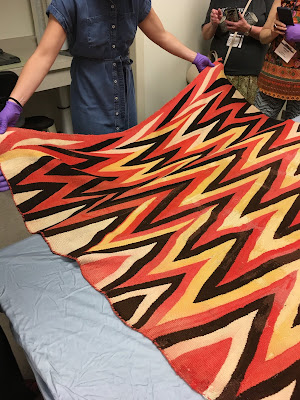Sometimes when I hear a moving performance of choral music, or see a work of art, or an entire exhibit, that resonates powerfully with me, I feel encouraged, in the literal sense of "filled with courage." I take heart. I see (or hear) evidence that humans are still capable of making beauty, taking precious time and infinite care to craft something that is rewarding to experience. The artist decides that for now, in making this piece of music, or this work of art, concerns around the efficient use of time, the production of a useful product, of marketing, branding, commerce and so on, are irrelevant. The imperative to make
this thing, to convey
this emotion, in these hard-won colors and forms, is paramount.
I had this experience most recently at the
New Mexico Museum of Art. Sam and I went to see the show
Agnes Pelton: Desert Transcendentalist (on view in Santa Fe through January 5, 2020. See the last paragraph below for more info).
Agnes Pelton (1881-1961) worked a vein of spiritual abstraction informed by her interests in mysticism, numerology and yoga, and by the larger current of abstract painting of her time. As I looked at her paintings, I wondered immediately, Why is Agnes Pelton not as well-known and well-regarded as Georgia O'Keeffe? Pelton's paintings also demonstrate a fascination with the space and sky of the open desert, with the effects of light--of
glow--and a conviction that the desert sky is a locus of mystical meaning. One wall label says that Pelton's paintings in the late 1920s began to be "completely untethered from reality and move toward a surreal embodiment of light, space, and vibration that borders on science fiction."
Sam and I noticed that almost every painting contained some kind of horizon line, situating it in a kind of landscape. And almost every painting followed the composition of an icon, with a strong central image serving as a focal point. For these reasons alone, I suppose, I am predisposed to love her work!
These are a few of my favorite paintings from the exhibit.
 |
| Agnes Pelton, Ecstasy, oil on canvas, 1928 |
About this painting, the painter wrote a poem. Here are the first and last lines:
A flower bursts open / in rush of ecstasy to meet the Day. . . the life force gathered, / and swift and free / it opened, to the light.
 |
| Agnes Pelton, Voyaging, oil on canvas, 1931 |
As a fiber artist, of course my interest is piqued by anything that resembles the sinuous lines of thread. But then what. . . what of these elegant loops and swirls, suspended above a seascape? What of the bell in the upper right? Each of us must make our own meaning in front of this painting, or be content to rest in a contemplative state of not-knowing.
 |
| Agnes Pelton, Mother of Silence, oil on canvas, 1933 |
According to the wall label, this painting is an abstract rendering of Pelton's mother, a huge influence on the artist, and the "Holy Mother Spirit." Pelton used this painting as an icon, a focus for her own meditation. A glowing, generative central figure floats above and between elongated orbs, radiating elegant thread-like lines. The jagged red line on the left reminds me a bit of the line traced on a EKG by the heartbeat. . . in any case it adds a jolt of angular energy, of movement in a painting that is otherwise about stillness.
 |
| Agnes Pelton, Fires in Space, oil on canvas, 1938 |
Unusually among the paintings in this show,
Fires in Space does not contain a horizon line or have a central iconic image--it is overall pattern, perhaps born of time spent gazing at the dark desert sky and its countless stars and galaxies.
It was sobering to read, on the last text panel in the exhibit, that when Pelton died in 1961, one of the paintings she had given to the Santa Barbara Gallery was put in a White Elephant Sale and marked down to $15. Pelton's work did not fit neatly into existing categories at the time, and so it was deemed disposable.
In the 1980s Pelton's work began to be studied, catalogued, and exhibited, and it seems that she is finally taking her rightful place as an important modernist and abstract painter. For me, it was en-
courage-ing to see an artist so committed to her own original vision, whether or not it was in fashion or marketable or even categorizable.
If you want to know more, visit the Santa Fe museum's website
here. The exhibit was organized by the Phoenix Museum of Art and a 30-second
video shows their installation. A 38-minute video lecture about Agnes Pelton by art historian Erika Doss is on YouTube
here. The exhibit will travel to the Whitney Museum in New York City in March 2020 and to the Palm Springs Art Museum in August 2020. The catalog of the show is available from the New Mexico Museum of Art
here, the Phoenix museum
here, and on Amazon
here.


















































